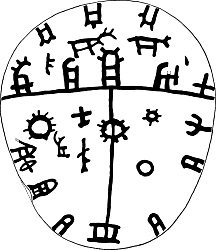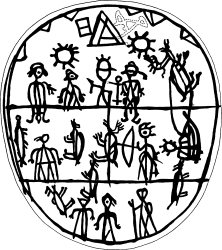Anund Eriksson’s Pite Sámi drum, published by Johannes Schefferus in 1673
In chapter 11 of Lapponia from 1673, Johannes Schefferus depicts six Sámi drums from different regions. While he had physical access to four of them – of which three still exists today – he starts with two which he only knew from drawings. While his woodcuts of the three surviving drums are fairly accurate representations, the very first he presents, drum ‘A’, deliberately misrepresents its source drawing, that of Samuel Rheen, as that drawing itself was so obviously distorted that he wanted to bring it more in line with the real drums he had access to.
The second drum, labelled ‘B’, is depicted in the same woodcut as the deliberately altered drum ‘A’. This raises the question of how accurately this renders his source, and indirectly the actual drum itself. Fortunately, when compared to surviving drums, the design seems rather credible, and the figures does not have the naïve interpretive style that Rheen’s drawing and several others do. The signs of both drums are marked with letters, and following this illustration is a brief legend explaining the signs. Here it is mentioned that drum ‘B’ was owned by Anundus Eerici, a Latinisation of Anund Eriksson.


In the woodcut, a scale bar labeled Pes Ro. (Roman foot) is placed between the two drums, which are drawn to the same size. As no mention of size is made in Rheen’s account, and Schefferus is otherwise not too prone to pure invention, this might be based on information from the account of Eriksson’s drum. It indicates a length of 32 cm; not entirely unreasonable for a bowl drum, the one from the British Museum shown above is 38.5 cm.
The interpretation of the symbols
The identification of the different symbols in the drawing by letters is in places problematic. Several symbols have no letter or explanation, and not all letters can be conclusively identified, in part because the list of interpretations contains one entry more than the number of letters in the drawing.
Both the drawing and the list skips the letter k. As this letter is included on drum ‘A’ in the same woodcut, this must either be a peculiarity of Schefferus’ source or an unintended omission. Following y the list does not continue with z, but instead with the Greek β and γ. As α is neither in the drawing nor the list, and γ cannot be clearly identified in the drawing, I am wondering if β is not just a misreading of an ornate z, and the entry for γ in the list the result of a spurious splitting of an entry in two.
Due to the badly shaped letters, the entry in the list not corresponding to a figure could be any of r, v, y or γ. In the English edition of Lapponia from 1674 it is assumed to be r, but this is almost certainly wrong. The letter that is identified as u (=v) there does indeed look like v, but the unambiguous r in drum ‘A’ has the exact same shape. The drums also share the very unusual form of the letter q, and the figure has the preceding q and the following s as its closest neighbours. There are then two remaining candidates for v, y and γ. One is positioned between t and x and would therefore be a likely candidate for v, but it has a pronounced descender making this reading unlikely. The other is more ambiguous, and could be any of the three.
| a. | Deus Pater | God the Father |
|---|---|---|
| b. | Jeſus | Jesus |
| c. | Spiritus S. | the Holy Ghost |
| d. | S. Johannes | St. John |
| e. | mors difficilis | difficult death |
| f. | capra | goat |
| g. | ſciurus | squirrel |
| h. | cœlum | heaven |
| i. | Sol | the Sun |
| l. | lupus | wolf |
| m. | piſcis ſiik | whitefish |
| n. | urogallus | capercaillie |
| o. | amicitia cum rangiferis ſylveſtribus | friendship with wild reindeer |
| p. | Anundus Eerici (cujus fuit hoc tympanum) occidit lupum | Anund Eriksson (whose drum this was) killing a wolf |
| q. | dona | offerings |
| r. | lutra | otter |
| s. | Lapponum aliorum amicitia | friendship of other Sámis |
| t. | cygnus | swan |
| v. | ſignum ad explorandum ſtatum aliorum, & num morbus ſit curabilis | a sign to investigate the condition of others, and whether a disease is curable |
| x. | urſus | bear |
| y. | porcus | pig |
| β. | piſcis | fish |
| γ. | hic animam defert ad infernum | this carries a soul to the underworld |
Comments on the entries
a–d: In this position it is expected to find the highest gods of the Sámi pantheon, but here the signs are described as Christian entities. As always there are many different explanations for this, but most likely the informant was either deliberately hiding the true identities of the entities for fear of repercussions, or was using the Christian concepts as the closest analogues in order to explain their function. Any attempt to suggest identities based on other drum description would have to remain speculative.
e: As this sign is of a shape and a position that suggests a major deity, it is tempting to suggest that the letters c and e have switched places, especially given the general confusion surrounding the lettering. The content is also ambiguous; in the English edition of Lapponia from 1674, it is translated simply as “Death”. As nouns are generally capitalised there, this could mean “death” as an abstract concept or some form of personification of it. The original Latin expression literally means “difficult death”, but is is not obvious what that means. If we are allowed to assume that c and e are exchanged, it could be seen as a parallel to the similarly shaped sign in the upper part of Jon Lassen’s Ume Sámi drum, which is there identified as Rutu. However, on other drums where this being is identified, it is placed in connection with the representation of the underworld, and not among the celestial deities.
f–g: Both goats and squirrels are identified on other drums, but both are surprising to see in the upper part, where the most common animals are reindeer, bears and birds.
h: The term is ambiguous as to whether it means the physical sky or the capitalised “Heaven” in the sense of a godly realm. Regardless of this, it is consistent with other drum interpretations.
i: Similarly to the previous entry, this can refer to the physical sun, or some form of personification of it, i.e. a sun god. This too is consistent with other drum interpretations.
k: This letter is missing both from the illustration and the list of explanations, but see under p below.
l: Clearly a quadruped without prominent antlers, and as the presence of a tail makes it less likely to be a bear, a wolf is not an ureasonable interpretation. See also p below.
m–n: These are interpreted as specific species of respectively freshwater fish and wild fowl, and the figures are not inconsistent with this. However, it is not unreasonable to speculate if the underlying meaning could be that of saivo guelle, a fish or snake which can carry the spirit of the noaidi in the underworld, and saivo lodde, a similar companion in bird form. See also β below.
o and s: These have similar, rather abstract, shapes, and similar interpretations. There are no obvious parallels or competing interpretations from other drums.
p: This is one of two apparent hunting scenes; the other is not given a letter, but could from its position originally have been the missing k entry. While the quarry there is clearly a reindeer, it is in p drawn similar enough to figure l to support the interpretation of both as wolves. In this entry, the name of the owner of the drum is revealed, in Latinised form.
q: The 1674 Englih edition translates this as “gifts”, but I feel that parallels from other drum interpretations makes the more specific interpretation of “offerings” or “sacrifices” more likely to represent the meaning.
r: From hereon and to the end, it is not clear which letter refers to which symbol. The figure marked with the probable r is drawn more similarly to those interpreted as fishes than to the clear quadrupeds, but could yet easily represent an otter. The intermediate form could even be a conscious attempt to represents this animal’s semiaquatic habitat.
t and x: As these letters are both cross-shaped, they could possibly have the opposite identifications, but both the orientation of the letters and the correspondence between the figures and the interpretations strongly support the identification I have given here. This way, the swan t is broadly similar to the other bird identified, the caperaillie n, while the bear x is a large quadruped with neither prominent antlers nor a tail.
v: The interpretation given for this letter has a very clear parallel in another early description, entry 17 in the interpretation of Jon Lassen’s Ume Sámi drum. However, there it refers to a representation of the underworld, and not an animal as it seems to do here. The two most likely explanations are 1) that what I have tentatively identified as the letter v is the otherwise missing γ, and that v has been accidentally omitted from the drawing and could be any of the unmarked figures, or 2) that the letter was moved from another point beside the same figure when converted to a woodcut, but was originally meant to refer to a neighbouring one. In either case, I would regard the structure at the bottom of the line that divides the lower field, or the square with a diagonal stroke on the other side of the animal under the letter as the most likely candidates.
y: A pig is an uncommon animal to include on a drum, but the figures I have tentatively identified as y and v are both drawn as quadrupeds with neither prominent antlers nor a clear tail, so either of them would visually be consistent with such an interpretation.
β: Visually, this resembles figure m, strengthening the similar interpretation of both.
γ: This interpretation describes the figure it belongs to as a form of psychopomp or soul guide. As this is similar to the function of the saivo guelle (see m–n above), it is possible that γ was not intended as a separate entry, but meant as the continuation of the previous one.